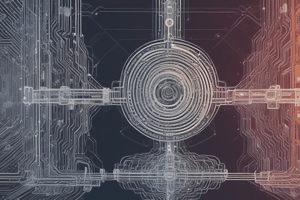Podcast
Questions and Answers
Which of the following is NOT a key aspect of computational thinking?
Which of the following is NOT a key aspect of computational thinking?
- Memorization of facts (correct)
- Algorithmic design
- Logical reasoning
- Problem-solving
Facial recognition systems utilize which computational thinking concept to distinguish between individuals?
Facial recognition systems utilize which computational thinking concept to distinguish between individuals?
- Pattern recognition (correct)
- Abstraction
- Algorithms
- Logical thinking
Which of the following is a key characteristic of an algorithm?
Which of the following is a key characteristic of an algorithm?
- Indefinite execution time
- Lack of clear steps
- Step-by-step method (correct)
- Randomness
Which computational thinking concept involves breaking down a complex problem into smaller, more manageable parts?
Which computational thinking concept involves breaking down a complex problem into smaller, more manageable parts?
Which of the following is a key aspect of logical thinking in computational thinking?
Which of the following is a key aspect of logical thinking in computational thinking?
What distinguishes deterministic algorithms from probabilistic algorithms?
What distinguishes deterministic algorithms from probabilistic algorithms?
How does abstraction contribute to hardware and software design in computing?
How does abstraction contribute to hardware and software design in computing?
What role does logical thinking play in effective debugging of programs?
What role does logical thinking play in effective debugging of programs?
How does computational thinking enhance problem-solving skills?
How does computational thinking enhance problem-solving skills?
Why are algorithms considered essential in automating tasks and scaling up operations?
Why are algorithms considered essential in automating tasks and scaling up operations?
Flashcards are hidden until you start studying
Study Notes
Computational Thinking: Understanding Pattern Recognition, Algorithms, Abstraction, Logical Thinking, and Problem Solving
Computational thinking is a cognitive skill that involves using computational processes to solve problems effectively. It encompasses various concepts such as pattern recognition, algorithms, abstraction, logical thinking, and problem solving. These aspects of computational thinking play a crucial role in developing skills necessary to understand, analyze, create, and deploy technologies, including information technology, software development, programming, data analysis, and visualization.
Pattern Recognition
Pattern recognition is the ability to identify and extract meaningful patterns from data. This process often involves machine learning techniques like clustering, classification, and anomaly detection. By recognizing these patterns, computational systems can make predictions, classify objects, and detect outliers based on historical data.
For instance, facial recognition systems rely heavily on pattern recognition. They learn to recognize specific features, such as eye shape, nose size, and jawline contour, to distinguish between individuals' faces. Similarly, predictive models can recognize patterns within financial transactions to flag potential fraudulent activities.
Algorithms
An algorithm is a step-by-step method for achieving a specific goal. In the context of computing, algorithms are used to perform complex tasks efficiently. There are two types of algorithms: deterministic and probabilistic. Deterministic algorithms always produce the same output given the same input, while probabilistic algorithms introduce randomness into their behavior to improve performance under certain conditions.
Algorithms are essential because they allow us to automate repetitive tasks and scale up operations. For example, sorting algorithms like quicksort, mergesort, and heap sort enable efficient organization of large datasets.
Abstraction
Abstraction refers to the process of simplifying complex systems by breaking them down into smaller components. By focusing on relevant details and ignoring unimportant ones, we can better understand complex issues and develop solutions more easily. Abstractions can range from simple descriptions to sophisticated mathematical models.
In computing, abstraction plays a significant role in both hardware and software design. For example, instead of designing every component of a computer at the atomic level, engineers abstract away unnecessary details to focus on building functional circuits. Additionally, object-oriented programming relies heavily on abstraction, allowing developers to modularize code and manage complexity.
Logical Thinking
Logical thinking is the ability to reason systematically and critically. It allows us to break down complex situations into simpler parts and evaluate possible outcomes based on available evidence. Logical reasoning helps us distinguish between facts and opinions, assess arguments, and draw valid conclusions.
In the realm of computing, logical thinking enables effective debugging of programs. Developers must think logically to find patterns in error messages and test hypotheses about why the program might behave unexpectedly. Moreover, understanding how computers manipulate symbols according to predefined rules also requires logical thinking.
Problem Solving
Problem solving involves identifying an issue, understanding its context, proposing solutions, evaluating consequences, and implementing changes. Computational thinking enhances problem-solving skills by providing tools and techniques to address complex problems effectively. These include breaking down large tasks into smaller components, developing algorithms, testing hypotheses, and verifying outcomes.
For example, when faced with an optimization problem like finding the shortest path between two points in a graph, computational thinking allows us to represent the problem as a mathematical model, apply appropriate algorithms, analyze potential solutions, and verify their validity.
Studying That Suits You
Use AI to generate personalized quizzes and flashcards to suit your learning preferences.




